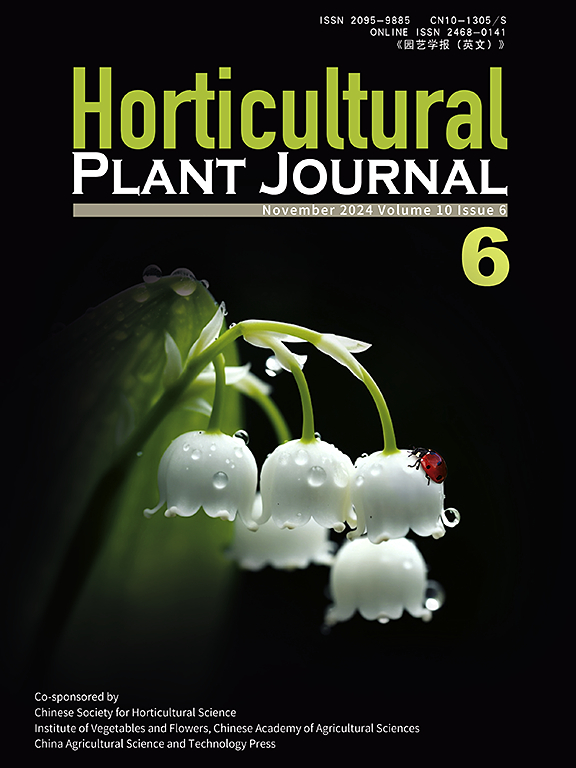Diverse functions of C2H2 zinc-finger transcription factors in growth regulation and stress adaptation in woody and perennial horticultural plants
IF 6.2
1区 农林科学
Q1 HORTICULTURE
引用次数: 0
Abstract
C2H2 zinc finger proteins (C2H2-ZFPs), one of the largest transcription factor families in plants, exhibit unique functional diversity in woody and horticultural species due to their modular architecture and regulatory flexibility. This review synthesizes recent advances in understanding their roles in perennial growth cycles and horticultural trait regulation, with a focus on their contributions to fruit development, secondary growth, and complex environmental adaptation. Structurally, C2H2-ZFPs harbor conserved zinc-coordinating motifs (C2H2 domains) and regulatory domains, enabling precise transcriptional control of developmental processes. In woody and horticultural plants, they integrate hormonal signals (e.g., auxin, ABA) and environmental cues (e.g., drought, photoperiod) to regulate seasonal dormancy and flowering timing in horticultural species, cambial activity for wood formation, and fruit ripening processes. Under abiotic stress, C2H2-ZFPs act as key modulators in ABA-dependent and independent pathways, governing osmotic balance, redox homeostasis, and stress memory. Meanwhile, emerging evidence also highlights their involvement in biotic stress responses. However, dissecting their regulatory networks in woody and horticultural species remains challenging due to genomic redundancy and complex regulatory layers. Future research should leverage multi-omics approaches and CRISPR-based tools to uncover their functional redundancy and species-specific adaptations, thereby advancing sustainable forestry and precision horticulture breeding under climate change.C2H2锌指转录因子在木本和多年生园艺植物生长调控和逆境适应中的多种功能
C2H2锌指蛋白(C2H2- zfps)是植物中最大的转录因子家族之一,由于其模块化结构和调控灵活性,在木本植物和园艺植物中表现出独特的功能多样性。本文综述了它们在多年生生长周期和园艺性状调控中的作用,重点介绍了它们在果实发育、次生生长和复杂环境适应中的作用。在结构上,C2H2- zfps含有保守的锌协调基序(C2H2结构域)和调控结构域,能够精确地转录控制发育过程。在木本和园艺植物中,它们整合激素信号(如生长素,ABA)和环境信号(如干旱,光周期)来调节园艺物种的季节性休眠和开花时间,木材形成的形成层活动和果实成熟过程。在非生物胁迫下,C2H2-ZFPs作为aba依赖和独立通路的关键调节剂,控制渗透平衡、氧化还原稳态和应激记忆。同时,新出现的证据也强调了它们参与生物应激反应。然而,由于基因组冗余和复杂的调控层,解剖木本和园艺物种的调控网络仍然具有挑战性。未来的研究应该利用多组学方法和基于crispr的工具来揭示它们的功能冗余和物种特异性适应,从而推进气候变化下的可持续林业和精准园艺育种。
本文章由计算机程序翻译,如有差异,请以英文原文为准。
求助全文
约1分钟内获得全文
求助全文
来源期刊

Horticultural Plant Journal
Environmental Science-Ecology
CiteScore
9.60
自引率
14.00%
发文量
293
审稿时长
33 weeks
期刊介绍:
Horticultural Plant Journal (HPJ) is an OPEN ACCESS international journal. HPJ publishes research related to all horticultural plants, including fruits, vegetables, ornamental plants, tea plants, and medicinal plants, etc. The journal covers all aspects of horticultural crop sciences, including germplasm resources, genetics and breeding, tillage and cultivation, physiology and biochemistry, ecology, genomics, biotechnology, plant protection, postharvest processing, etc. Article types include Original research papers, Reviews, and Short communications.
 求助内容:
求助内容: 应助结果提醒方式:
应助结果提醒方式:


